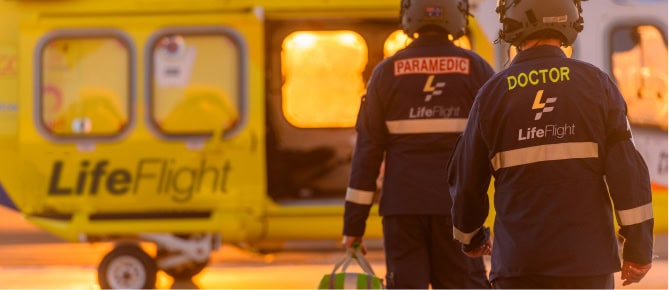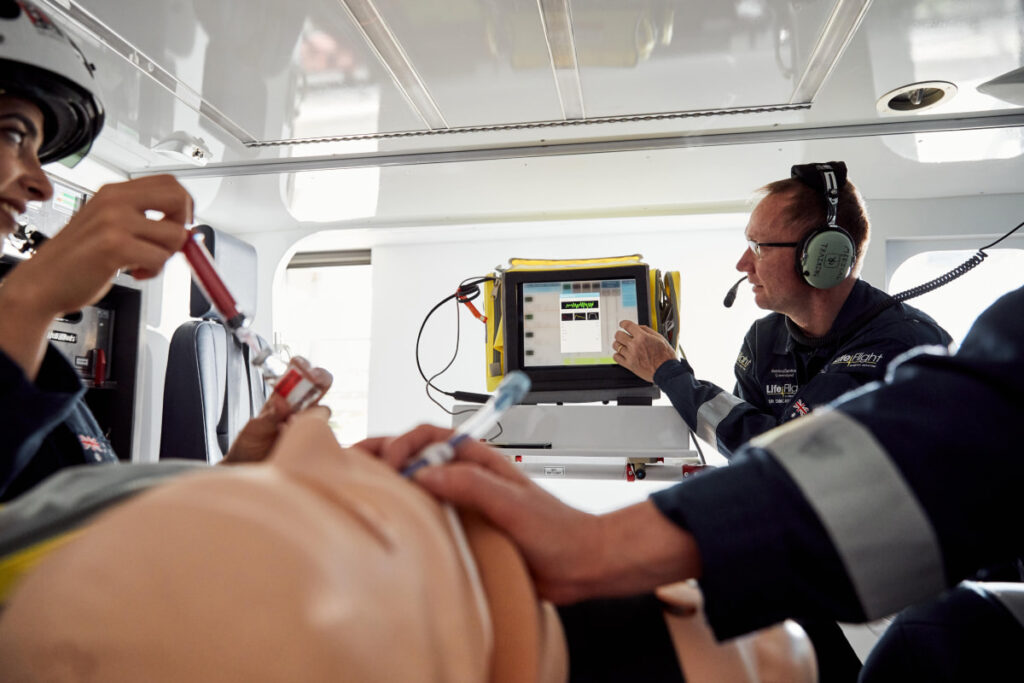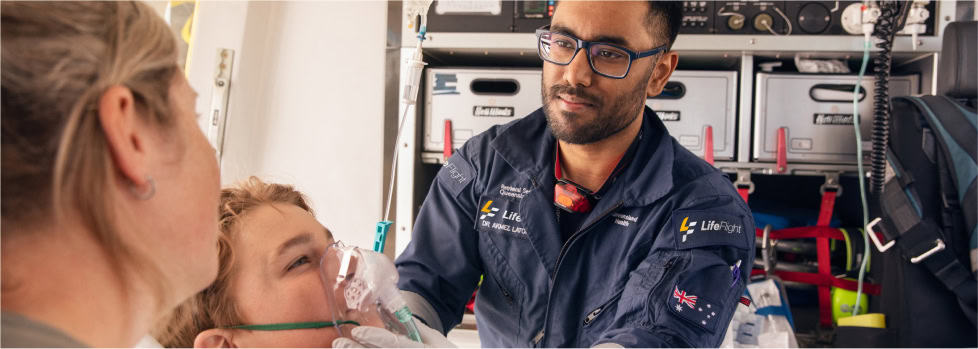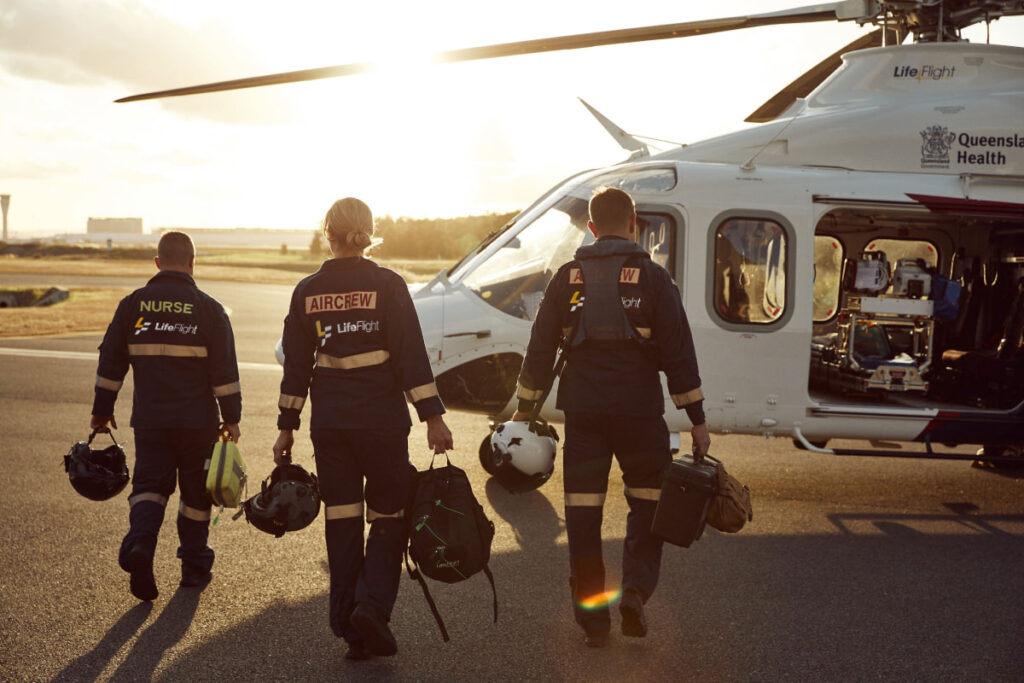At LifeFlight Medical Services, research is a core part of how we deliver high-quality aeromedical care. As a leader in prehospital and retrieval medicine, we are committed to advancing clinical practice, improving patient outcomes, and strengthening safety through rigorous, real-world research. Our work is shaped by frontline experience, collaborative inquiry, and a belief that evidence-based care drives better results.
Take a look at our latest findings, published articles and case reports that help shape the future of our care.
Methods: A retrospective review of 3,582 air medical trauma cases from a 3-year period in Queensland was conducted. An initial TRTS, GAP score, and SI were calculated for each patient, and the lowest in-flight mean arterial pressure and systolic blood pressure were determined. The institution of in-flight critical care interventions was also recorded, including fluid resuscitation, vasopressors, and surgical procedures. The utility of the TRTS, GAP score, and SI for predicting in-flight hypotension was then examined using receiver operating characteristic curves.
Results: All 3 approaches showed minor predictive value, with the GAP score performing slightly better than TRTS and SI for predicting in-flight interventions. The GAP score had a receiver operating characteristic area under the curve of 0.76 compared with 0.74 for the TRTS and SI.
Introduction: There is limited published data on the burden of cardiac disease among patients requiring emergency medical evacuation from the Great Barrier Reef, a popular tourist destination in Far North Queensland, Australia. The aim of this study was to examine the characteristics and outcomes of patients with cardiac conditions who were retrieved from the northern Great Barrier Reef to Cairns Hospital.
Methods: This observational study was a planned substudy of a broader analysis of medical retrievals from the Cairns/Cooktown section of the Great Barrier Reef. It included all patients retrieved to Cairns Hospital between July 2016 and January 2020 who were assigned a cardiac diagnosis during their hospital stay. Data were collected about electrocardiograph, cardiac troponin blood test and invasive coronary angiography results as well as final hospital diagnosis.
Results: During the study period, 120 patients were retrieved from the Great Barrier Reef to Cairns Hospital, of which 46 (38%) were subsequently diagnosed with a primary cardiac condition(s) or other disease process with clinically significant cardiac involvement. The most common diagnoses were type 2 myocardial infarction (20; 16.7% of all retrievals), primary cardiac arrhythmia (14; 12.5%) and acute coronary syndrome (5; 4.2%). An elevated troponin was recorded in 30% of all retrievals and in 78% of those with a cardiac diagnosis. A total of 14 (30.4%) of patients with a cardiac diagnosis died during their hospital admission. Invasive coronary angiography was performed in 18 cases, of which six patients had obstructive coronary artery disease. Four patients required percutaneous coronary intervention.
Conclusion: A high proportion of patients retrieved to Cairns Hospital from the Great Barrier Reef were diagnosed with a primary cardiac condition. This data may assist tourism operators, retrieval organisations and health services to plan for, and respond to, cardiac events among visitors to the reef.
In this case, we describe the completion of emergency front-of-neck access by a novice provider facilitated by specialist telehealth support. A facility with limited advanced airway skills requested telehealth support for a critically unwell patient with severe hypoxic respiratory failure and acute delirium. Attempts to temporise his physiology with ketamine-facilitated non-invasive ventilation were unsuccessful, and he proceeded to rapid sequence intubation. Ultimately, intubation was unsuccessful and attempts at ventilation by laryngeal mask also failed. A Cannot Intubate, Cannot Oxygenate scenario was identified. The referring team had significant anxiety about performing a surgical front-of-neck access procedure. However, with telehealth support, this was ultimately completed by a novice provider, and the patient stabilised. The key issue identified was the need for the telehealth provider to take clinical governance of the procedure. The referring team also required assistance in completing an adequate neck incision, responding to bleeding, and determining the preferred technique.
Objective: Bariatric anatomy and physiology present added clinical challenges to the provision of safe critical care and patient transport. LifeFlight Retrieval Medicine provides air medical retrieval services in Queensland, Australia, and performs over 6,000 retrieval missions annually using rotary wing, fixed wing, and ground ambulance platforms.
Methods: Bariatric patient retrievals were identified from the LifeFlight Retrieval Medicine electronic patient database. These cases were interrogated to quantify and describe adverse events during patient transport.
Results: Over the study period from July 2019 to December 2021 11,096 patient retrievals were completed. Of these patients, 816 (7.3%) had a body weight ≥ 120 kg (range, 120-246 kg; median = 146 kg). Bariatric patients were more likely to be male (70%) and to require critical care interventions than nonbariatric patients (25.9% vs. 19.9%). There was an absolute 1.5% increase of high-interest events during patient retrieval, corresponding to a 1.9-fold increased relative risk. Five hundred eleven of 11,096 patients were intubated by the retrieval team, and 61 of these weighed ≥ 120 kg. Bariatric patients undergoing intubation were of similar age and sex, weighed significantly more, had nonsignificant trends toward poorer airway visualization by Cormack-Lehane laryngoscopic grade, and tended toward reduced first-attempt success compared with nonbariatric patients. Rates of airway adverse events (AAEs) were significantly increased for the bariatric group (30/61, 49.2%) compared with the nonbariatric group (135/450, 30.0%) (χ2 likelihood ratio, P = .004). Postintubation desaturation was the most common AAE and was the only criterion significantly increased when comparing bariatric (26%) versus nonbariatric (12%) patients (χ2 likelihood ratio, P = .005). Using patient weight as a continuous variable, nominal logistic regression revealed a significant effect of increasing weight on AAEs (χ2 = 12.9, P = .0003) with a threshold of 105 kg providing an optimal 88% sensitivity for predicting AAEs. The odds of AAEs were increased significantly for those weighing 105 to 119 kg versus those weighing < 105 kg (odds ratio [OR] = 3.4; 95% confidence interval [CI], 1.6-7.5) and for those weighing ≥ 120 kg versus those weighing < 105 kg (OR = 2.5; 95% CI, 1.4-4.3). There was no difference between those weighing ≥ 120 kg versus those weighing 105 to 119 kg (OR = 0.73; 95% CI, 0.3-1.8).
Conclusion: Air medical retrieval of bariatric patients is safe despite an increased risk of adverse events. Strategies to optimize emergency anesthesia should be used to maximize safe intubation in bariatric patients.
Objective: To define the utility of the Triage Revised Trauma Score (TRTS), GCS/Age/arterial Pressure (GAP) score, and shock index (SI) in predicting the need for in-flight blood product administration in civilian trauma patients transported by an aeromedical platform.
Methods: A retrospective chart review of 3582 aeromedical trauma cases was conducted. An initial TRTS, GAP score and SI were calculated for each patient, and the administration of in-flight blood products was also recorded. Receiver operating characteristic (ROC) curves were used to quantify the predictive discrimination of the TRTS, GAP score and SI on the need for in-flight blood product administration.
Results: The SI showed a superior predictive value compared to the TRTS and GAP score. The SI showed an area under the curve on the ROC curve of 0.85 in both primary and inter-hospital transfer cases, indicating reasonable predictive value.
Conclusion: The SI demonstrates favourable test characteristics for predicting the need for in-flight blood product administration. Prospective validation of these results is warranted.
Methods: Retrospective observational study of VAPOX performed at LifeFlight Retrieval Medicine (LRM) between January 2018 and December 2022 across Queensland, Australia. Demographic and clinical data were recorded. Descriptive statistics and paired Student’s t-tests were used to evaluate the efficacy of VAPOX on oxygen saturation (SpO2).
Results: VAPOX was used in 40 patients. Diagnoses included pneumonia (n = 11), COPD (n = 6) and neurological (n = 7). Patients were intubated in hospital (n = 36), in helicopter (n = 2) and ambulance (n = 2). Median VAPOX settings were: positive end-expiratory pressure 6 (IQR 5–9), pressure support 10 (IQR 10–14) and back up respiratory rate 14 (IQR 11–18). Twelve agitated patients underwent delayed sequence induction with ketamine. There was a statistically significant increase in SpO2 after application of VAPOX (P < 0.001), followed by a slight decrease after intubation (P = 0.006). Mean SpO2 were significantly improved after intubation compared with on arrival of LRM (P = 0.016). Hypotension was present prior to VAPOX (n = 13), during VAPOX (n = 2) and post-intubation (n = 15). Two patients had cardiac arrest. Three patients were started on VAPOX but subsequently failed. There were no significant oxygen depletion or aspiration events.



Research at LifeFlight is made possible through the generous support of community donations and competitive research grant funding. We are especially grateful to partners like the Emergency Medicine Foundation (EMF), whose ongoing support enables us to drive innovation and improve outcomes in pre-hospital and retrieval medicine. Continued investment in research helps our teams investigate meaningful questions, explore new treatments, refine clinical practices, and ultimately save the lives of Queenslanders.

Have questions about our research or want to learn more about our latest projects?
We’d love to hear from you!
Email us at: research@lifeflight.org.au
